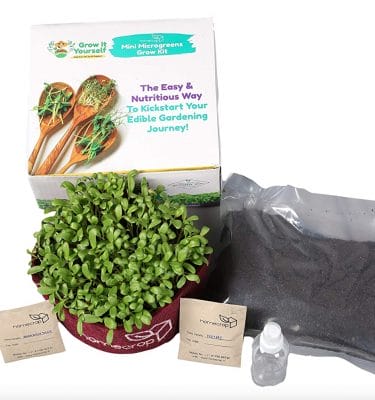Explore Nature’s Nutrition Treasure
With Our All-Inclusive Microgreens Kits
Our all-inclusive microgreens kits make growing your own fresh, organic microgreens super easy.
View this post on Instagram
-
Microgreens Kit Combo: Cabbage & Mustard
Original price was: ₹1,000.₹900Current price is: ₹900. -
Microgreens Kit Combo: Pink Radish & Red Cabbage
Original price was: ₹1,000.₹900Current price is: ₹900. -
Microgreens Kit Combo: Red Cabbage & White Radish
Original price was: ₹1,000.₹900Current price is: ₹900. -
Microgreens Kit Combo: Kasuri Methi & Wheat Grass
Original price was: ₹1,000.₹900Current price is: ₹900. -
-
-
-
-
-
-
-


Frequently Asked Questions
General Information
1. What are microgreens?
A microgreen is the new, tender shoot of a vegetable plant. It’s what happens if you let a sprouted seed go a little bit further into growing, but don’t let it completely mature. These small plants are easy to grow in confined spaces. A small outlay can provide a significant return in terms of bulk, variety, and nutrients. As they take just a few days to grow, it is possible to have an ongoing source of microgreens. By rotating three crops, for example, you could have fresh microgreens every week.
2. What is the difference between microgreens and sprouts?
Sprouts are usually are grown in water and are harvested within 2 days while Microgreens need sunlight and usually take 1-2 weeks depending on variety.
3. I don’t have any experience of growing plants? Can I still grow?
Yes of course! Microgreens is one of the easiest to kickstart your edible garden journey. Because you harvest super early there is nothing you can mess up with!
4. What type of microgreens are not safe to eat?
Never grow microgreens of night shade plants- tomatoes, peppers, potatoes, peppers, eggplant. They contain toxins in their stems that can make you very well.
Grow kit related questions
1. What is meant by mini microgreens kit?
These are single serve kits, an inexpensive way to start growing microgreens for sandwiches, salads and garnishes.
2. What is the container made of?
The container is a breathable fabric grow bag which is ecofriendly and reusable. The bag is porous in nature; therefore, the excess water will be drained from the sides of the container. No additional holes at the bottom of the container are necessary
3. Can I re-use the cocopeat and the container after the first harvest of microgreens?
Yes, you can re-use the cocopeat and the container. Sundry the cocopeat after the harvest for a day or two and reuse it for the second cycle.
4. What do I do if my seeds are not germinating?
Microgreen seeds germinate best in soil kept consistently moist throughout the first few days after planting. If you haven’t seen adequate germination within 3 days of planting, check your soil moisture and add more water to your bag if it is too dry. You can also try to pre-soak seeds before sowing them, it ensures that the seeds are not in their dormant state. Try to pre-soak your seeds for 8-12 hours before sowing, it works wonders.
If you continue experiencing germination issues, please reach out to our team on 8179982232 and we’ll help you get growing
Care Related Questions
1. I see white growth around my roots. Is it a fungus or a mould?
If you are worried about the white fuzzy growth around the roots of your seedlings, it is not mould. It’s root hair and is a natural part of the process of germination and growth.
There is a difference between root hair and mould. Root hair is generally lighter and typically surrounds the root area. Whereas, mould is darker, heavier and covers bare soil or the surrounding seeds. Mould on the microgreen is no different from the mould in the environment. It thrives on bacteria, high humidity, less air circulation, unclean containers or pots.
2. How do I fix the mould problem?
Here is what you can do:
• The right amount of sunlight and ventilation are effective ways to prevent your microgreens from moulds. After germination, move your microgreens to a spot where there are direct sunlight and good ventilation.
• Do not over populate your bag with seeds- Too many seeds can crowd the plant and make your microgreens a host for mould. Give your microgreens their own space to grow.
• One of the most common causes of moulds is overwatering. Keep your microgreens moist and hydrated without flooding them.
3. How much light does microgreens require to grow?
Microgreens are very young plants, so for their ~10-14 days of growing they only need a moderate amount of light to give them rich colour and an abundance of nutrients! We recommend finding a space for your bag that receives day-long indirect light or a few hours of direct light. Note that watering levels will vary based on temperature and amount of sunlight, so monitor your microgreens carefully and adjust lighting and/or water accordingly
Tip: Place your bag in a place where you will see it every day. This will remind you to add water and you will be able to just see how quickly your microgreens will be ready for harvest
4. How much water do I add to my microgreens and how often?
In general, microgreens will grow well in damp but not over-saturated mix. Seeds prefer a more moist environment during germination. However do not flood the mix. Check and give a mist spray by the checking the moisture levels
5. How long will it take for my microgreens to be ready?
Your microgreens should be ready to harvest between day 7 and day 14 after planting. Greens will have grown several inches , though seedling height will vary based on lighting and soil conditions during growth.
Microgreens can be harvested and eaten at any point once they’ve grown above the mix
6. My microgreens are falling off. What is the reason?
Seeing microgreens fall is a sad sight to see. The microgreens that are in the centre of the tray start to lean over to the sides of the bag. This could be due to the deficiency of water or light. If it is dry, It’s time to water them well but ensure that the mix is moist and not soggy.
Low light level is one of the reasons why your microgreens are falling off, these little greens need proper lighting to grow well. Keeping them in blackout after germination can lead to tall and floppy produce.
7. Why do my microgreens look yellow?
During germination, it is normal for your microgreens to be yellowish in colour as they have not been exposed to any sunlight and haven’t had a chance to photosynthesize yet. Once you expose your microgreens to the sun, they will start to turn green.
The greens may have leggy stems if you keep them in the dark more than the required time.
8. My microgreens are growing in an uneven manner. What is the reason?
It could be due to the following reasons:
• There’s a tendency to overpopulate the bag/container while sowing the small seeds like basil etc and when they start germinating, they’ll compete for the limited sources they are getting which can lead to uneven growth. Make sure to spread the seeds uniformly across the bag to ovoid uneven growth
• Where you place your bag -To prevent uneven growth you need to ensure that your entire bag receives equal treatment of shade and light during and after the germination period.





